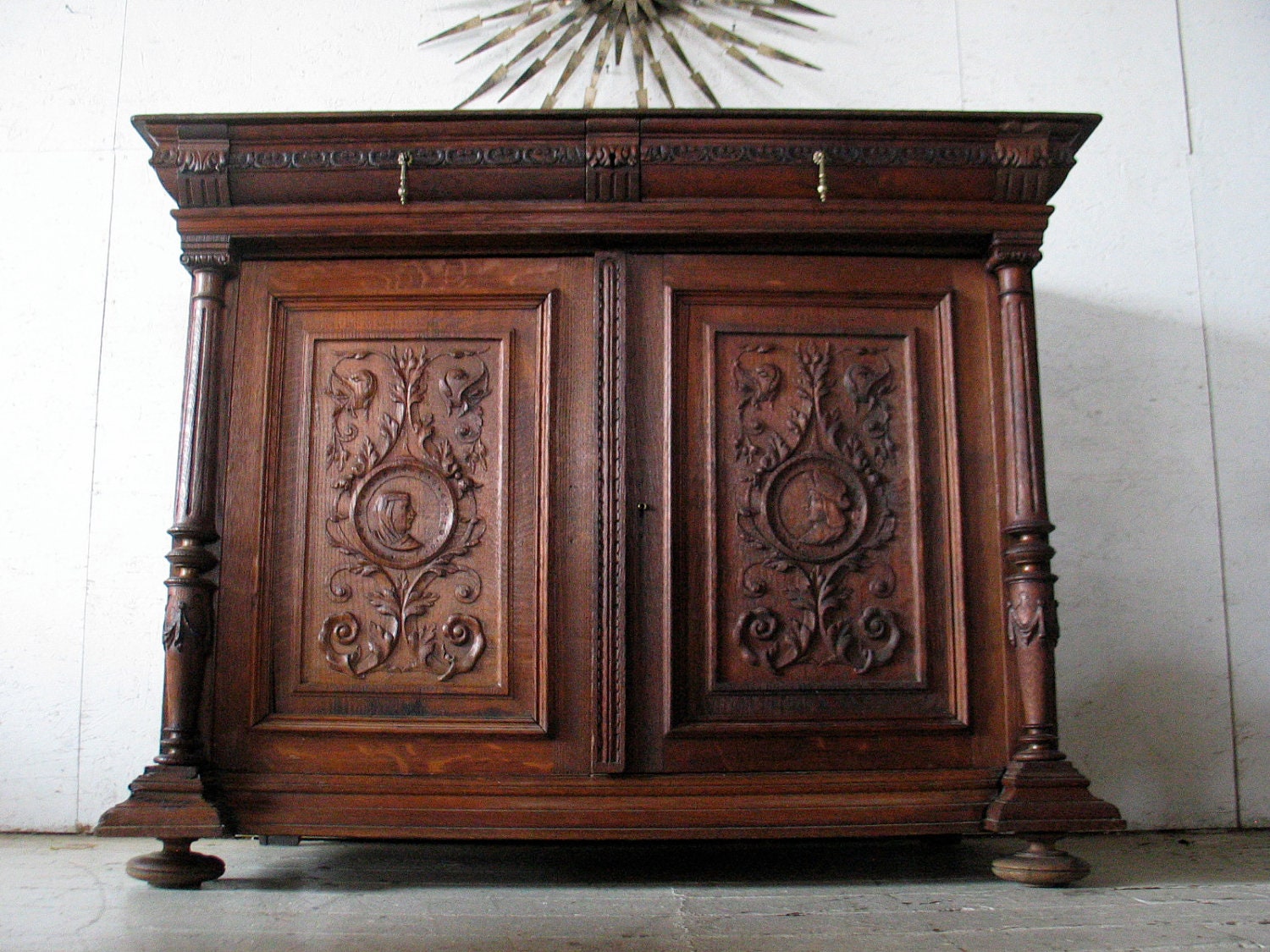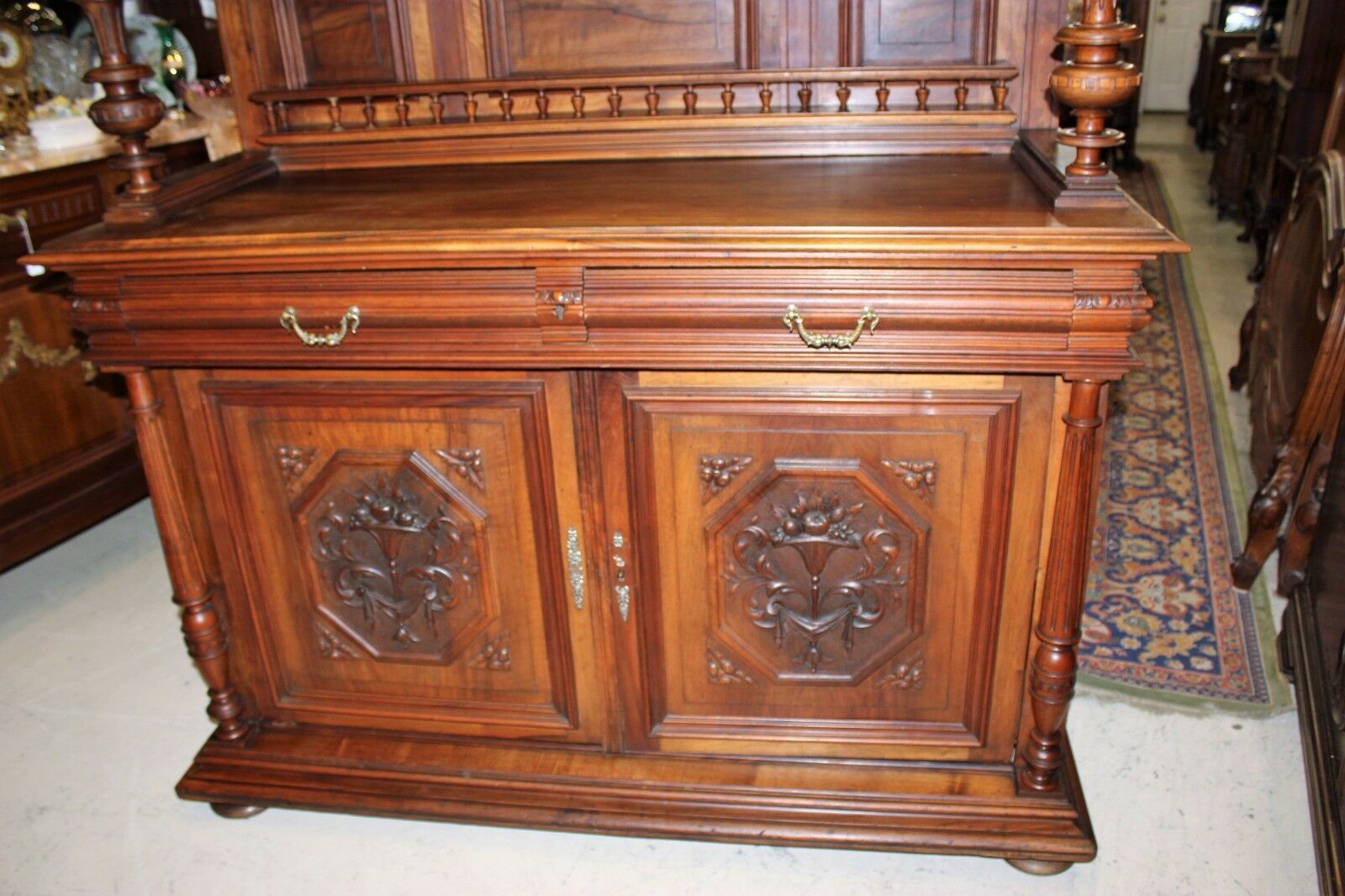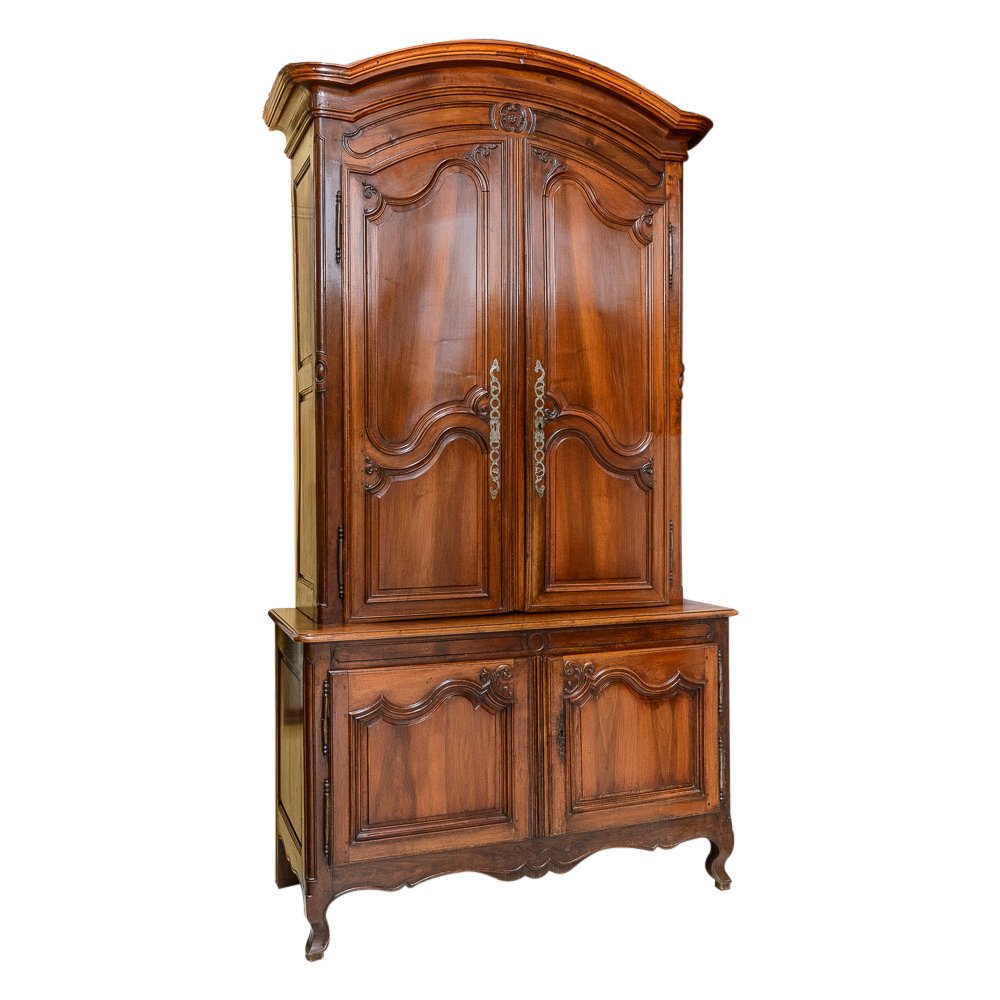History and Origin

French buffet cabinets, also known as armoires, have a rich history that spans centuries, reflecting evolving styles and craftsmanship. Their evolution is closely tied to the changing tastes and social structures of French society.
Evolution of Styles, Antique french buffet cabinet
The design and construction of French buffet cabinets underwent significant transformations throughout history, mirroring the dominant architectural and artistic movements of each era.
- Medieval Period (12th-15th centuries): Early buffet cabinets were primarily functional, often made of oak or walnut with simple designs. They were designed for storage and display of valuable items, reflecting the emerging merchant class.
- Renaissance Period (16th century): The Renaissance brought a renewed interest in classical art and architecture, influencing furniture design. Buffet cabinets became more elaborate, incorporating intricate carvings, decorative moldings, and classical motifs.
- Baroque Period (17th century): The Baroque era emphasized grandeur and opulence. Buffet cabinets were often massive, featuring ornate carvings, gilded surfaces, and elaborate marquetry. They were often commissioned by wealthy patrons and displayed in grand palaces and mansions.
- Rococo Period (18th century): Rococo style emphasized elegance, grace, and asymmetry. Buffet cabinets during this period featured delicate curves, shell-like motifs, and playful ornamentation. They were often made of lighter woods, such as cherry or maple, and embellished with painted decorations.
- Neoclassical Period (late 18th and early 19th centuries): The Neoclassical movement sought to revive the ideals of ancient Greece and Rome. Buffet cabinets during this period were characterized by straight lines, geometric shapes, and classical motifs. They were often made of mahogany or rosewood and featured intricate veneers.
- Art Nouveau Period (late 19th and early 20th centuries): Art Nouveau embraced organic forms, flowing lines, and natural motifs. Buffet cabinets during this period featured stylized floral designs, asymmetrical shapes, and decorative metalwork.
Craftsmanship and Materials
The construction of antique French buffet cabinets showcases exceptional craftsmanship and attention to detail.
- Woods: Oak, walnut, cherry, maple, mahogany, and rosewood were commonly used. The choice of wood depended on the desired aesthetic and the period’s style.
- Carving: Carving was a prominent decorative element, ranging from simple geometric patterns to intricate scenes and floral motifs.
- Marquetry: Marquetry, the art of inlaying different woods to create intricate designs, was a popular technique. It added depth and visual interest to the surfaces of buffet cabinets.
- Gilding: Gilding, the application of gold leaf, was often used to enhance the beauty and opulence of buffet cabinets, particularly during the Baroque and Rococo periods.
- Hardware: Antique French buffet cabinets often featured ornate brass or bronze hardware, including hinges, handles, and locks.
- Finishes: Polishes, varnishes, and lacquers were used to protect and enhance the wood’s natural beauty and to create different finishes, from matte to high gloss.
Renowned Cabinetmakers
Several renowned French cabinetmakers played a significant role in shaping the design and construction of antique French buffet cabinets.
- André-Charles Boulle (1642-1732): Boulle was a master of marquetry and known for his intricate designs using ebony and brass. He was favored by King Louis XIV and his work is considered a high point of French furniture design.
- Jean-Henri Riesener (1734-1806): Riesener was a prominent cabinetmaker during the Neoclassical period, known for his elegant and refined designs. He worked for the French royal family and was renowned for his use of exotic woods and veneers.
- Jacob-Desmalter (1759-1841): Desmalter was a prolific cabinetmaker who worked during the Empire style, characterized by its emphasis on grandeur and military themes. He created furniture for Napoleon Bonaparte and other prominent figures.
Styles and Design: Antique French Buffet Cabinet

Antique French buffet cabinets are renowned for their exquisite craftsmanship and elegant designs, reflecting the evolution of artistic styles and cultural trends throughout history. These cabinets embody the artistry and technical prowess of French cabinetmakers, showcasing a diverse range of decorative motifs, materials, and construction techniques.
Styles of Antique French Buffet Cabinets
Antique French buffet cabinets are classified into various styles, each characterized by distinctive design elements and historical influences. Some of the most popular styles include:
- Louis XIV (1643-1715): This style is characterized by its grandeur and opulence, reflecting the power and splendor of the Sun King’s reign. Louis XIV furniture is typically massive and ornate, featuring intricate carvings, gilded surfaces, and elaborate marquetry.
- Louis XV (1715-1774): This style represents a shift towards a more graceful and refined aesthetic. Louis XV furniture is known for its curvilinear forms, asymmetrical designs, and use of natural materials like mahogany and walnut.
- Louis XVI (1774-1793): This style embodies the ideals of Neoclassicism, emphasizing simplicity, symmetry, and geometric forms. Louis XVI furniture often features straight lines, fluted columns, and delicate floral motifs.
- Empire (1804-1814): This style emerged during the reign of Napoleon Bonaparte and drew inspiration from ancient Roman and Egyptian art. Empire furniture is characterized by its bold lines, monumental proportions, and decorative elements such as sphinxes, eagles, and laurel wreaths.
Design Elements
Antique French buffet cabinets showcase a wide array of design elements that contribute to their aesthetic appeal and historical significance.
Carvings
Carvings are a prominent feature of antique French buffet cabinets, often depicting floral motifs, mythological creatures, or scenes from classical literature. The level of detail and artistry in these carvings varies depending on the style and the period of production.
Inlays
Inlay work is another common decorative technique used on antique French buffet cabinets. This involves inserting materials such as wood, ivory, or metal into the surface of the cabinet to create intricate patterns and designs.
Hardware
Hardware plays a crucial role in the functionality and aesthetic appeal of antique French buffet cabinets. Handles, hinges, and locks are often crafted from brass, bronze, or silver, and may feature elaborate designs that complement the overall style of the cabinet.
Decorative Motifs
Antique French buffet cabinets are adorned with a variety of decorative motifs, reflecting the artistic tastes and cultural influences of the period. Common motifs include:
- Floral motifs: Flowers, vines, and leaves are popular decorative elements, symbolizing beauty, nature, and abundance.
- Mythological creatures: Griffins, sphinxes, and other mythological creatures are often incorporated into the design, representing power, wisdom, and strength.
- Classical motifs: Roman and Greek architectural elements, such as columns, pilasters, and friezes, are often incorporated into the design, reflecting the influence of Neoclassicism.
- Geometric patterns: Geometric patterns, such as chevrons, diamonds, and circles, are frequently used to create visual interest and add a sense of order to the design.
Value and Appreciation

Antique French buffet cabinets are not merely pieces of furniture; they are historical artifacts, works of art, and valuable investments. Their value is influenced by a complex interplay of factors, making them highly sought-after by collectors and connoisseurs.
Factors Affecting Value
The value of an antique French buffet cabinet is determined by a combination of factors, including:
- Age: Generally, older cabinets command higher prices, with pieces from the 18th and 19th centuries being particularly valuable. The age of a cabinet can be determined through various methods, including examining its construction techniques, style, and materials.
- Condition: The condition of a cabinet is crucial. Well-preserved cabinets with minimal wear and tear, original finishes, and intact hardware are highly prized. Cabinets that have been restored or repaired may still hold value but will generally be worth less than those in original condition.
- Provenance: Knowing the history of a cabinet, its previous owners, and where it has been can significantly increase its value. A documented provenance adds authenticity and credibility to a piece.
- Rarity: Unique designs, unusual materials, or limited production runs can make a cabinet more valuable. For example, a cabinet made by a renowned cabinetmaker or featuring intricate carvings or marquetry would be considered rare and highly sought-after.
- Style: Different periods in French furniture design, such as Louis XIV, Louis XV, and Louis XVI, are associated with distinct styles and characteristics. Cabinets from these periods often command higher prices due to their historical significance and aesthetic appeal.
Significance in Interior Design and Historical Preservation
Antique French buffet cabinets are not just valuable; they are also highly desirable for their aesthetic and historical significance. In interior design, these cabinets add a touch of elegance and sophistication to any space. Their intricate details, rich finishes, and timeless designs complement a wide range of décor styles.
Antique French buffet cabinets also play a crucial role in historical preservation. They serve as tangible reminders of past eras and cultural traditions. By preserving these pieces, we can learn about the craftsmanship, design aesthetics, and lifestyles of previous generations.
Value Estimation
The value of antique French buffet cabinets can vary significantly depending on the factors discussed above. However, the following table provides a general overview of estimated values for different types of cabinets:
| Type | Materials | Key Features | Estimated Value |
|---|---|---|---|
| Louis XIV Buffet | Walnut, oak, ebony, ivory | Intricate carvings, marquetry, gilded bronze mounts | $10,000 – $50,000+ |
| Louis XV Buffet | Mahogany, rosewood, walnut | Curved lines, cabriole legs, ormolu mounts | $5,000 – $30,000+ |
| Louis XVI Buffet | Mahogany, satinwood, rosewood | Straight lines, neoclassical designs, bronze mounts | $3,000 – $20,000+ |
| Empire Buffet | Mahogany, rosewood, bronze | Grand scale, Egyptian motifs, ormolu mounts | $4,000 – $25,000+ |
| Art Deco Buffet | Walnut, mahogany, lacquered wood | Geometric patterns, bold lines, metal accents | $2,000 – $15,000+ |
It is important to note that these values are estimates and can vary greatly depending on the specific cabinet’s condition, provenance, and rarity.
Antique French buffet cabinets, with their intricate carvings and rich patina, often serve as focal points in a room, showcasing treasured possessions. While these pieces exude elegance and history, for modern technology needs, a sturdy and functional tripp lite 18u rack enclosure server cabinet provides a secure and organized environment for servers and network equipment.
Both the antique buffet and the modern server cabinet serve as essential storage solutions, each reflecting a different era and purpose.
Antique French buffet cabinets, with their intricate carvings and rich patina, exude a timeless elegance. While these pieces offer ample storage for fine china and linens, they might not be the most practical solution for today’s footwear needs. For a contemporary approach to shoe storage, the mataro contemporary shoe cabinet provides a sleek and efficient solution.
Its minimalist design and ample storage compartments allow for easy organization, while its contemporary aesthetic complements modern interiors. In contrast to the ornate grandeur of antique French buffet cabinets, the mataro contemporary shoe cabinet offers a clean and functional approach to footwear storage, highlighting the evolution of design and practicality in furniture.
